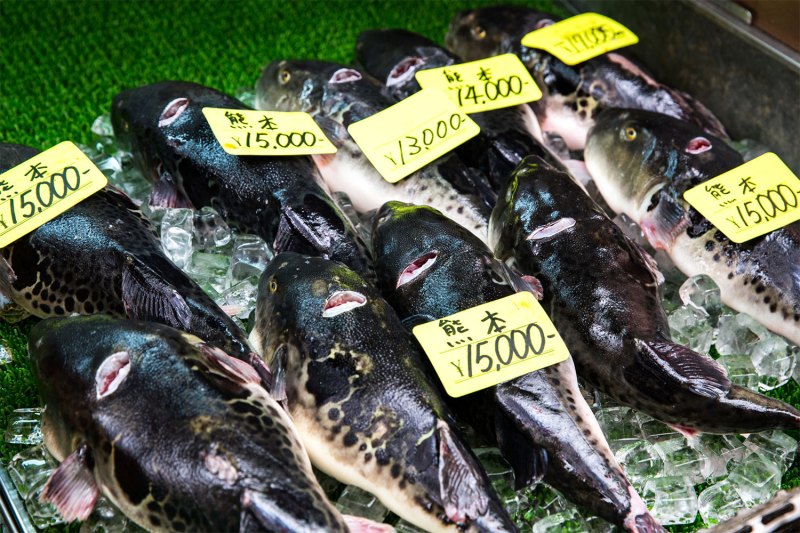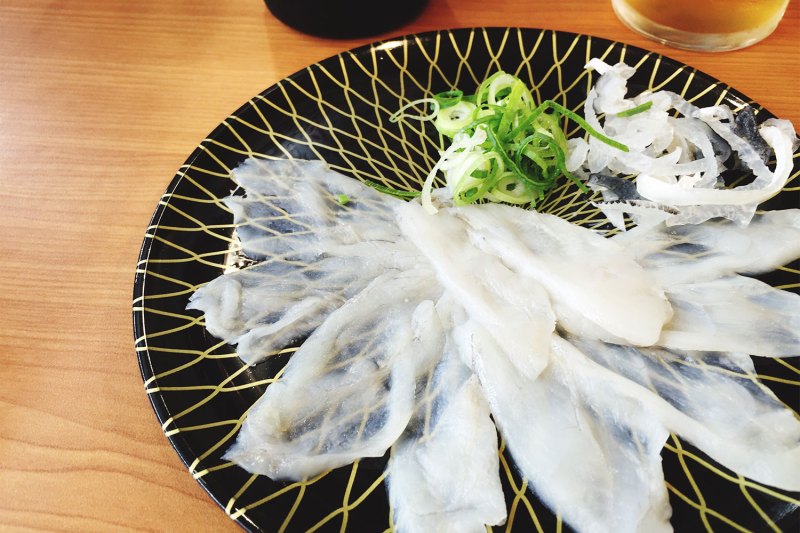In the wide, wide world of cuisine, there’s not much that can compare to fugu. The traditional Japanese method of preparing pufferfish involves two things humans are apparently always hungry for: A one-of-a-kind dish and a brush with our own mortality.
Within many of the pufferfish’s vital organs is enough cyanide to kill you several times over. Its liver alone is estimated to contain enough of the poison to end five adult humans’ lives. That’s a potent stat, especially given that the fish is about the size of a football. So dangerous is working with fugu liver that the fish’s organ was banned entirely in Japan in 1984.

In the Yamaguchi prefecture of Japan, fugu is legend. Here, there are statues devoted to the spiny sea critter, along with enough mythology to fill up several textbooks. At places like the Karato Market in Shimonoseki, it’s been coveted for ages, sold to bidders and ultimately processed in meticulous ways to remove all toxic parts. Chefs in Japan undergo a rigorous three-year program just to be able to work with the potentially lethal fish. It’s widely viewed as legend and not fact, but some still believe that the best chefs are able to leave a trace amount of poison in the fish, enough to give the diner numb, slightly tingling lips.
Because it’s not taken lightly, you don’t hear as much anymore about fugu-related fatalities. But every now and then, you do hear about somebody getting ill or even perishing, typically after preparing at home without the proper training. Whatever it tastes like, it’s fair to say that part of fugu’s major draw is the danger element. And it’s hard not to envision a scene like this one from The Simpsons when it’s ordered.

In Tokyo, fugu is still seen as a wintertime delicacy. The dish fetches several hundred dollars a plate, often prepared as sashimi or chirinabe, a Japanese fish stew of sorts. In Japan and China, locals have been cooking with the fish for more than 2,000 years. It’s rumored that ancient Egyptians used pufferfish for a recreational sport something like bowling. The tiger pufferfish is the most poisonous and, historically, also the most revered. You can find the fish and its closest siblings in generally warmer seas all over the planet, from Australia to Hawaii.
It’s easy to see why the fish adores Shimonoseki especially. The coastal southwestern part of Japan looks like the Florida Keys of the Far East, with its turquoise waters and island-spanning bridges.
Modern research has equipped the farmers of today to raise poison-free fugu in parts of Japan. For thrill seekers, it’s a decidedly less sexy version. But for those looking to avoid any chance of what sounds like an awful way to go (paralyzed muscles while remaining completely conscious), it’s a welcome option.

What does fugu taste like? The reviews are all over the board. Some call the flavor a more delicate version of chicken, or downright uneventful. The consistency is somewhat rubbery. But the platings, never mind the inherent thrill, can be gorgeous. And as with so many exotic dining adventures, it’s more about the journey than the first bite.
Prior to the pandemic, a few restaurants outside Japan served the dish, like Restaurant Nippon in New York. Morimoto in Philadelphia and Shiki in Seattle. The full experience, however, seems to involve not only a flirtatious dance with death but a trip to the south of Japan where fugu is king.
Editors' Recommendations
- Rich and Earthy: A Definitive Guide to Haitian Cuisine
- The Ultimate Guide To Lebanese Cuisine, a Rich and Distinct Food Culture
- For A Refreshing And Satisfying Summer Supper, Look No Further Than Larb
- Takibi Portland Will Combine Camping and Japanese Cuisine
- The Story Behind Benihana, the World-Famous Japanese Steakhouse


